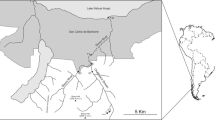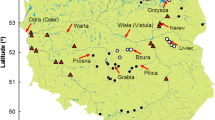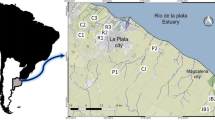Abstract
This field ecological study, based on the chironomid pupal exuvial technique (CPET), is new for the Paraná River and proposes an efficient tool to be used in future ecological approaches and biomonitoring. Drifting of pupal exuviae in a river-floodplain system of the Middle Paraná River floodplain was represented by 34 Chironomidae taxa, being the characteristic association obtained from the CPET: Lopescladius, Onconeura, Paralauterborniella, Polypedilum, and Harnischia complex. Diversity, richness, dominance, total density, and density of dominant taxa were different between the longitudinal and lateral dimensions but not between hydrologic phases, with a greater diversity and richness in the main channel of the river and higher density and dominance in floodplain habitats. The species turnover is the dominant process in structuring studied assemblages in spatial and temporal analysis, increasing in the floodplain habitats and in low-water phase. The results obtained showed that drifting exuviae in the longitudinal axis were coming from different assemblages and environments of a wider area (regional), while exuviae recorded in the connections of the floodplain environments in the lateral dimension could reflect the local assemblages. We demonstrated the ecological value of CPET studies to interpret the attributes of Chironomidae assemblage in river-floodplain systems of large rivers in an integrated way.




Similar content being viewed by others
References
Anderson AM, Ferrington LC Jr (2013) Resistance and resilience of winter-emerging Chironomidae (Diptera) to a flood event: implications for Minesota trout streams. Hydrobiologia 707:59–71
Baselga A (2010) Partitioning the turnover and nestedness components of beta diversity. Glob Ecol Biogeogr 19:134–143
Baselga A, Orme CDL (2012) Betapart: an R package for the study of beta diversity. Methods Ecol Evol 3:808–812
Cranston PS (1996) Identification guide to the Chironomidae of the New South Wales. Australian Water Technologies Pty Ltd, West Ryde, NSW, p 376
Drago EC (2007) The physical dynamics of the river–lake floodplain system. In: Iriondo MH, Paggi JC, Parma MJ (eds) The Middle Paraná River. Limnology of a subtropical wetland. Springer, Berling Heidelberg, New York, pp 83–122
Ezcurra de Drago I, Marchese M, Montalto L (2007) Benthic invertebrates. In: Iriondo MH, Paggi JC, Parma MJ (eds) The Middle Paraná River. Limnology of a subtropical wetland. Springer, Berling Heidelberg, New York, pp 251–275
Fend SV, Carter JL (1995) The relationship of habitat characteristics to the distribution of Chironomidae (Diptera) as a measure by pupal exuviae collections in a large river system. J Freshw Ecol 10:342–359
Ferrington LC (1987) Collection and identification of surface floating pupal exuviae of Chironomidae for use in studies of surface water quality. EPA Standard Operating Procedure N° FW 130 A. ENSV, Kansas
Ferrington Jr. LC, Blackwood MA, Wright CA, Crisp NH, Kavannaugh JL, Schmidt FJ (1991) A protocol for using surface-floating pupal exuviae of Chironomidae for rapid bio assessment of changing water quality
García PE, Añón Suarez DA (2007) Community structure and phenology of chironomids (Insecta: Chironomidae) in a Patagonian Andean stream. Limnologica 37:109–117
Hammer Ø, Harper DAT, Ryan PD (2009) PAST−PAlaeontological STatistics, ver. 1.89
Hardwick RA, Cooper PD, Cranston PS, Humphrey CL, Dostine PL (1995) Spatial and temporal distribution patterns of drifting pupal exuviae of Chironomidae (Diptera) in streams of tropical northern Australia. Freshw Biol 34:569–578
Heino J (2005) Metacommunity patterns of highly diverse stream midges: gradients, chequerboards, and nestedness, or is there only randomness? Ecol Entomol 30:590–599
Iriondo M (2007) Geomorphology. In: Iriondo MH, Paggi JC, Parma MJ (eds) The Middle Paraná River. Limnology of a subtropical wetland. Springer, Berling Heidelberg, New York, pp 33–52
Junk WJ, Bayley PB, Sparks RE (1989) The flood pulse concept in river-floodplain systems. Can Spec Publ Fish Aquat Sci 106:110–127
Marchese M, Ezcurra de Drago I, Drago E (2002) Benthic macroinvertebrates and physical habitat relationships in the Paraná River flood-plain system. In: McClain ME (ed) The ecohydrology of South American rivers and wetlands. IAHS Spec Publ no. 6, pp 111–130
Marchese M, Paggi AC (2004) Diversidad de Oligochaeta (Annelida) y Cironomidae (Diptera) del Litoral Fluvial Argentino. In: Aceñolaza FA (ed) Temas de la Biodiversidad del Litoral Fluvial Argentino. INSUGEO, Ediciones Magna, Tucumán, pp 217–224
Mauad M, Siri A, Donato M (2016) Does type of substratum affects chironomid assemblage composition? A study in a river catchment in Northern Patagonia, Argentina. Neotrop Entomol https://doi.org/10.1007/s13744-016-0429-3
McGill JD, Wilson RS, Brake AM (1979) The use of chironomid pupal exuviae in the surveillance of sewage pollution within a drainage system. Water Res 13:887–894
Medina AI, Scheibler EE, Paggi AC (2008) Distribución de Chironomidae (Diptera) en dos sistemas fluviales ritrónicos (Andino- serrano) de Argentina. Rev Soc Entomol Argen 67:69–79
Mesa LM, Marchese MR, Montalto L, Zilli FL (2012) Bidirectional exchanges of benthic invertebrates in a large river–floodplain system (Paraná River, Argentina). Ann Limnol-Internat J Limnol 48:425–436
Montalto L, Paggi AC (2006) Diversity of chironomid larvae in a marginal fluvial wetland of the Middle Paraná River floodplain, Argentina. Ann Limnol-Internat J Limnol 42:289–300
Neiff JJ (1999) El régimen de pulsos en ríos y grandes humedales. In: Malvarez AI (ed) Tópicos sobre humedales subtropicales y templados de Sudamérica. UNESCO, Montevideo, pp 97–146
Paggi AC (2009) Diptera Chironomidae. In: Dominguez E, Fernandez HR (eds) Macroinvertebrados bentónico sudamericanos. Sistemática y biología. Fundación Miguel Lillo, Tucumán, pp 383–410
Paggi AC, César I, Rodrigues Capítulo A (1998) Benthic studies in the zone of islands of Yacyretá prior to impoundment of the Upper Paraná River (Argentina). Verh Internat Verein Limnol 26:1089–1094
Paoli C, Schneider M (eds) (2000) El río Paraná en su tramo medio. Contribución al conocimiento y prácticas ingenieriles en un gran río de llanura. Tomo I. Centro de Publicaciones de la Universidad del Litoral, Santa Fe, p 307
Petsch DK, Pinha GD, Dias JD, Takeda AM (2015) Temporal nestedness in Chironomidae and the importance ofenvironmental and spatial factors in species rarity. Hydrobiologia 745:181–193
Pinha GD, Aviz D, Lopes Filho DR, Petsch DK, Marchese MR, Takeda AM (2013) Longitudinal distribution of Chironomidae (Diptera) downstream from a dam in a neotropical river. Braz J Biol 73:549–558
Raunio J, Heino J, Paasivirta L (2011) Non-biting midges in biodiversity conservation and environmental assessment: findings from boreal freshwater ecosystems. Ecol Indic 11:1057–1064
Raunio J, Ihaksi T, Haapala A, Muotka T (2007a) Within-and among-lake variation in benthic macroinvertebrate communities-comparison of profundal grab sampling and the chironomid pupal exuvial technique. J N Am Benthol Soc 26:708–718
Raunio J, Muotka T (2005) The use of chironomid pupal exuviae in river biomonitoring: the importance of sampling strategy. Arch Hydrobiol 164:529–545
Raunio J, Paasivirta L, Hämäläinen H (2010) Assessing lake thropic status using spring-emerging chironomid pupal exuviae. Fundam Appl Limnol 176:61–73
Raunio J, Paavola R, Muotka T (2007b) Effects of emergence phenology, taxa tolerances and taxonomic resolution on the use of the chironomid pupal exuvial technique in river biomonitoring. Freshw Biol 52:165–176
Ruse LP (1995) Chironomid community structure deduced from larvae and pupal exuviae of a chalk stream. Hydrobiologia 315:135–142
Siqueira T, Roque FO, Trivinho-Strixino S (2008) Phenological patterns of neotropical lotic chironomids: is emergence constrained by environmental factors? Aust Ecol 33:902–910
Siqueira T, Bini LM, Cianciaruso MV, Olivera Roque F, Trivinho-Strixino S (2009) The role of niche measures in explaning the abundance-distribution relationship in tropical lotic chironomids. Hydrobiologia 636:163–172
Scheibler EE, Pozo V, Paggi AC (2008) Distribución espacio-temporal de larvas de Chironomidae (Diptera) en un arroyo andino (Uspallata-Mendoza), Argentina. Rev Soc Entomol Argent 67:45–58
Thomaz SM, Bini LM, Bozelli RL (2007) Floods increase similarity among aquatic habitats in river-floodplain system. Hydrobiologia 579:1–13
Wiedenbrug S (2000) Studie zur Chironomidenfauna aus Bergbächen von Rio Grande do Sul, Brazilien. Ph.D Thesis, Munich, Ludwig-Maximilians-Universität
Wiederholm T (1986) Chironomidae of the Holartic region—keys and diagnoses. Part 2. Pupae-Entomol Scand Suppl 28:1–482
Wilson RS, Bright PL (1973) The use of chironomids pupal exuviae for characterizing streams. Freshw Biol 3:283–302
Wilson RS, Ruse LP (2005) A guide to the identification of genera of chironomid pupal exuviae occurring in Britain and Ireland (including common genera from northern Europe) and their use in monitoring lotic and lentic fresh waters. Special Publication No. 13. Freshw Biol Assoc. Ambleside
Zilli FL, Paggi AC (2013) Ecological responses to different degrees of hydrologic connectivity: assessing patterns in the bionomy of benthic chironomids in a large river-floodplain system. Wetlands 33:837–845
Acknowledgments
This study was supported by CAI+D 2011-535 (Universidad Nacional del Litoral) and PICT (Agencia Nacional de Promoción Científica y Tecnológica) 2012-2095. The authors are grateful to the anonymous reviewers and Mercedes Marchese for the critical reading of their article and their valuable suggestions, which contributed to improve the manuscript. We thank Mónica Cavilia and Proof Reading Service for language assistance. We are also grateful to Esteban Creus and Eduardo Lordi for their field assistance and Leticia Mesa for her assistance in the statistical analyses. This paper is Scientific Contribution No. 972 of the Instituto de Limnología “Raúl A. Ringuelet” (ILPLA, UNLP).
Author information
Authors and Affiliations
Corresponding author
Additional information
Edited by Edison Ryoiti Sujii – Embrapa/Cenargen
Rights and permissions
About this article
Cite this article
Mestre, A.P., Paggi, A.C. & Montalto, L. The Application of Chironomid Pupal Exuvial Technique (CPET) for Ecological Analysis in a Neotropical Large River System. Neotrop Entomol 47, 619–627 (2018). https://doi.org/10.1007/s13744-017-0562-7
Received:
Accepted:
Published:
Issue Date:
DOI: https://doi.org/10.1007/s13744-017-0562-7




